Solving Food Insecurity and the Climate Crisis in India
Farmers in India (Photo by Lech Magnuszewski)
Are there nature-based methods for fighting food insecurity, nutrient deficiency, and climate change in the world’s most populous nation? The answer is a definitive yes, according to the recent review article “India’s Biogeochemical Capacity to Attain Food Security and Remediate Climate,” published in the journal Environmental Geochemistry and Health.
This study, led by Dr. Ishfaq Ahmad Mir, was a collaborative effort of researchers from the Geological Survey of India, the Global Coral Reef Alliance, and Remineralize the Earth (RTE). The work highlights the remarkable promise of using natural soil amendments, such as locally sourced rock dust and biochar produced from agricultural waste, to restore degraded soils and improve crop nutrient density while simultaneously addressing climate change through nature-based carbon storage. More specifically, this paper surveys India’s vast agrogeological resources, laying out the technical basis for planning and implementing this nature-based solution throughout the country. The paper also provides a call to action, pointing out that a national research and development program is needed to optimize the agrogeological and biological mixtures (local rock dust, biochar, and composts) for India’s distinct combination of crops, soils and climate.
This study has received a high level of attention from both scientists and policymakers due to the urgency of the food insecurity, nutrient deficiency, and climate hazard issues in India. Top experts are realizing that the nature-based strategies laid out in the paper represent a powerful, equitable, and low-cost approach to addressing these issues.
For example, Professor Rattan Lal, one of the world’s leading soil scientists and winner of the Japan Prize (2019) and The World Food Prize (2020), on reading the article commented: “Indeed, it is a very important reference material on a topic of great importance.”
The Problem: Climate Hazards and Soil Nutrient Depletion in India
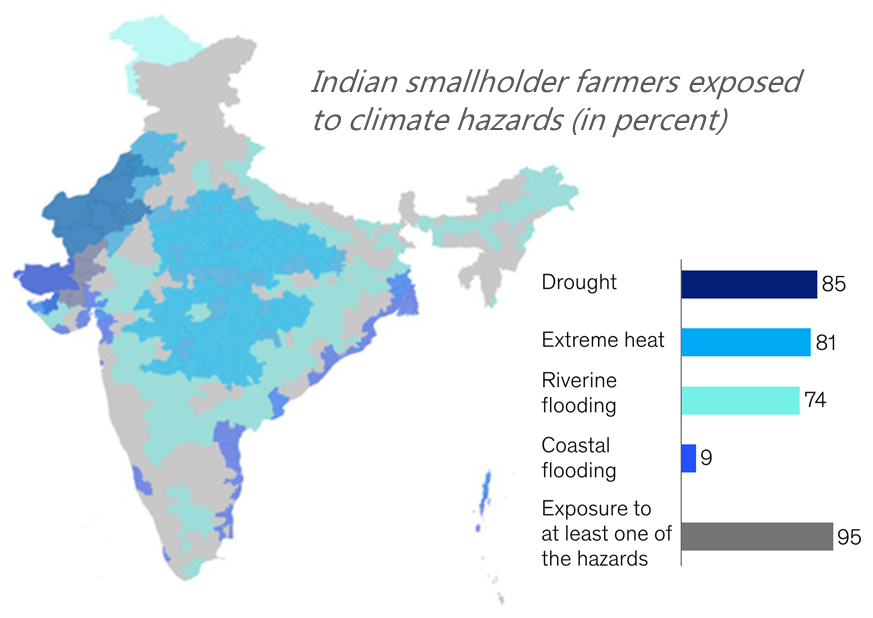
As described in a recent RTE feature article on the Indian nonprofit Mati Carbon Removals, a 2023 McKinsey Research study found that 95% of Indian smallholder farmers will be exposed to at least one major climate hazard, such as drought, extreme heat, and flooding, if warming continues at the present rate. The following map shows the vast distribution of climate risks across India.
This map paints a dire picture for Indian farmers: 85% will be affected by drought, 81% by extreme heat, and 74% by flooding related to climate change. The 2023 McKinsey report also shows that by 2050, changing weather patterns could result in the loss of hundreds of thousands of hectares of land currently suitable for rainfed rice cultivation throughout India and Southeast Asia. This could force millions of farmers to change their livelihoods. These climate threats have enormous food security implications as hundreds of millions of people throughout India depend on local farmers for food.
These observations underscore the urgency of implementing large-scale carbon dioxide removal and highlight the need for agricultural interventions that will offer farmers sustainable solutions for boosting crop resilience and yield. Climate change and food security are thus intimately intertwined, making a solution that can target both problems invaluable.
Another primary health concern in India is nutrient deficiency. Many soils in India are depleted of nutrients, which limits agricultural productivity. This is a major food security and nutrient deficiency risk due to the growing population. Mir et al. (2023) point out that despite recent increases in food production in India, intensive farming has depleted soils of micro- and macro-nutrients and hence reduced the nutritional quality of food (Denton-Thompson and Sayer, 2022). Plant nutrients are removed from the soil when crops are harvested, and if not replaced by new minerals, the productivity and nutrient density of the crops will eventually fall, thus endangering the health of entire communities. And while synthetic fertilizers (i.e., nitrate, phosphate, and sulfate salts) can provide a short-term boost in crop yield, their use eventually depletes the soil in essential micronutrients and can significantly damage local ecosystems.
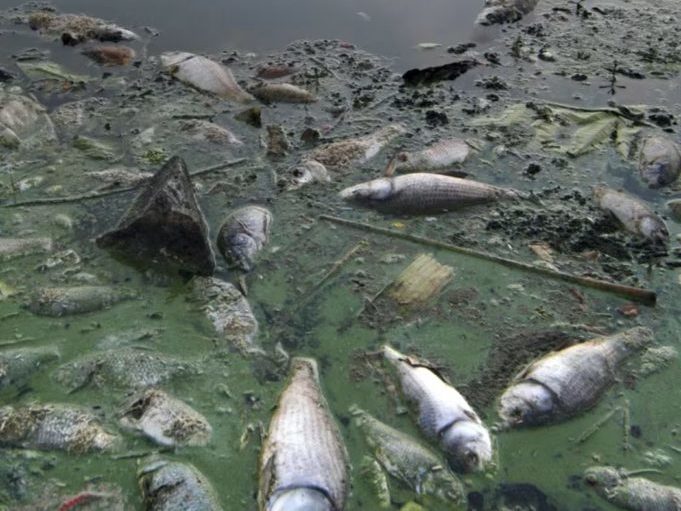
As Mir et al. (2023) explained, because synthetic fertilizers lack most of the minor and trace elements essential for plant health, their ability to absorb macronutrients such as nitrogen and phosphorus decreases. This leads to excess nitrogen and phosphorus accumulating in soils, which eventually causes these nutrients to end up in local streams, lakes, and coastal areas. Increased nitrogen and phosphorus in local water bodies cause algal blooms, which damage aquatic and coastal ecosystems by blocking sunlight and depleting waters of oxygen (i.e., eutrophication).
The main point here is that using more synthetic fertilizer to address food security is unsustainable and damages vital ecosystems that provide important services (e.g., fisheries) for marginalized communities.
Fortunately, as discussed by Mir et al. (2023), there is another solution—A sustainable, nature-based solution.
The Solution: Locally Sourced Rock Dust, Biochar, and Sustainable Farming Methods
The sustainable solution detailed by Mir et al. (2023) combines locally sourced agrogeological materials (i.e., rock dust from mines and quarries) with biochar produced by burning agricultural wastes and invasive plant species (such as mesquite) in pollution-free stoves and kilns. These kilns burn organic material in a low-oxygen environment at high temperatures and capture the gas and liquid wastes produced during combustion. The resulting charcoal-like material (biochar) has many remarkable soil-enhancing properties. As described by Mir et al. (2023):
“When matured with rock powder and organic compost, biochar makes an ideal long-lasting slow-release fertilizer since nutrients released from weathering and organic matter decomposition are retained by the biochar. The large-scale adoption of converting agricultural waste to biochar can be achieved through concerted education efforts and interactions with local farmers. This biochar and education effort would be performed as part of a large-scale outreach effort advocating the use of both rock dust and biochar as soil amendments.”
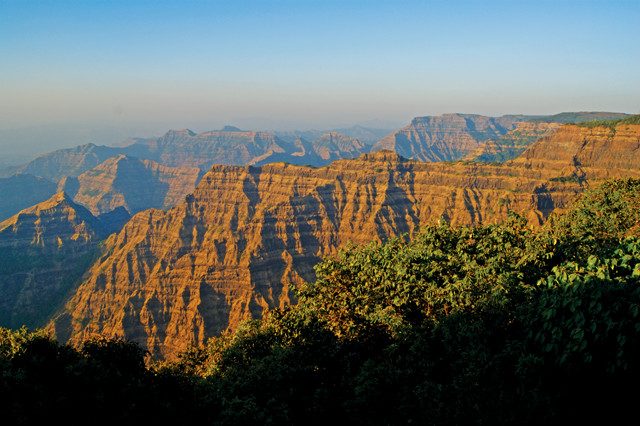
There are widespread invasive plants in India that are inedible by livestock and thus make great candidates for biochar production. These plants, such as thorny Prosopis juliflora and toxic Lantala, render potential farm and pasture lands useless except as sources of firewood. The conversion of these weed plants into biochar will turn unproductive agricultural lands into working farms, pastures, or orchards while simultaneously providing a source of long-lasting carbon storage material (e.g., see Goreau, 2020). Furthermore, if biochar production becomes a common practice, replacing traditional agricultural waste burning, it can dramatically improve some of the world’s worst air pollution in Northwest India.
As Mir et al. (2023) discuss, India has a wealth of agrogeological resources due to its tumultuous geologic history. The most promising agrogeological materials for soil remineralization are igneous rocks, such as the volcanic rock type called basalt. India has one of the world’s largest deposits of basalt (the Deccan Traps), which cover over 500,000 square kilometers, making it readily accessible in many of India’s major agricultural regions.
A wealth of scientific data shows the effectiveness of using biochar and rock dust for soil restoration, nutrient enrichment, and crop yield (Allohverdi et al., 2021; Swoboda et al., 2022). The list of rock-dust benefits is extensive. Some of the most important benefits highlighted by Mir et al. (2023) are:
- Rock dust (basalt in particular) is an excellent source of key major, minor, and trace nutrients such as magnesium, calcium, phosphorus, silicon, iron, manganese, copper, and zinc.
- Improving soil nutrient profiles increases plant growth and resistance to pests and disease (decreasing the need for chemical pesticides and herbicides). This increases soil organic carbon, thus improving soil texture while also increasing soil carbon storage.
- The improved soil nutrient profile also stimulates food crops to produce more vitamins and enriches them in essential trace nutrients that improve human health, such as zinc.
- Increased crop yield will also improve local economies and support food security in farming communities. This increased economic activity (from abundant harvests) will improve climate hazard resilience in marginalized communities.
- The weathering of magnesium and calcium-rich minerals in rock dust increases soil pH through the conversion of carbon dioxide into a geologically stable form of carbon called carbonate (bicarbonate, the main ingredient in baking soda, is the most common type of carbonate molecule).
- The conversion of carbon dioxide to bicarbonate during rock dust weathering not only increases (i.e., improves) soil pH but also traps carbon in a stable form that can keep it out of the atmosphere for thousands of years. In this way, rock weathering acts as a powerful and natural carbon dioxide removal technique (under the right conditions).
- In addition, bicarbonate produced by rock weathering counteracts ocean acidification as it is transported by local streams to coastal areas. This process significantly benefits ocean ecosystems.
- Using rock dust for soil remineralization also minimizes agricultural chemical runoff that pollutes freshwater bodies and coastlines (as mentioned above).
The following infographic from Mir et al. (2023) provides a more complete list of the major combined benefits of rock dust + biochar soil amendments.

A recent white paper from the Carbon Removal India Alliance adds further support for using biochar and rock dust as soil amendments in India. The following figure is from a webinar/panel discussion hosted by the Carbon Removal India Alliance as part of the 28th Conference of the Parties to the UN Framework Convention on Climate Change (COP28). The diagram quantifies some major benefits of large-scale rock dust and biochar application in India. For more information on this important presentation and panel discussion, see the following RTE summary article.
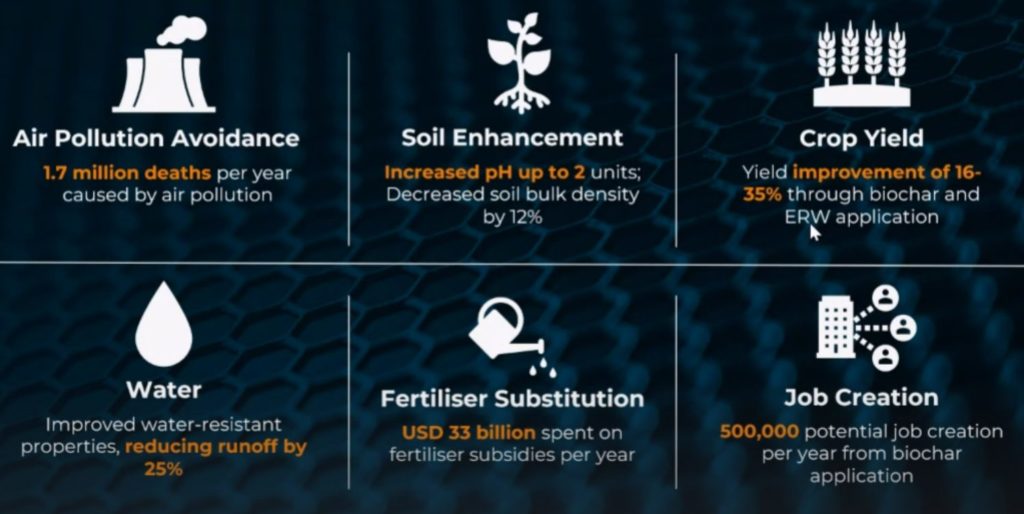
Mir et al. (2023) also identify several challenges associated with the large-scale implementation of soil remineralization in India. For example, issues can arise when trying to convince farmers to trust new, unfamiliar soil additives. In addition, there are potential logistic, economic, and environmental issues associated with the large-scale production of biochar and rock extraction. However, none of these issues pose significant problems. All of them can be addressed through controlled field trials demonstrating the effectiveness, economic benefit, and environmental safety of this traditional nature-based soil remineralization strategy.
Conclusion
In their recent review article “India’s Biogeochemical Capacity to Attain Food Security and Remediate Climate,” Dr. Mir and colleagues highlight a sustainable, nature-based strategy for fighting food insecurity, nutrient deficiency, and climate change in India. The paper provides a survey of India’s agrogeological resources needed to implement this strategy at scale. The authors identify the major advantages of using a mixture of locally sourced rock dust and biochar to remineralize and restore degraded soils while simultaneously removing carbon dioxide from the atmosphere. In addition to providing the technical basis for implementing this, the authors also offer a call to action. They propose a national research and development program focused on optimizing the agrogeological mixture (and associated sustainable farming methods) for India’s varied soil/crop/climate regimes. The bottom line is that this important paper points towards a sustainable solution that could revolutionize agricultural practices and efforts to fight food insecurity and climate change throughout India and, by extension, the global south in general.
James Jerden is an environmental scientist and science writer focused on researching and promoting sustainable solutions to urgent environmental problems. He holds a Ph.D. in geochemistry from Virginia Tech and a Master’s degree in geology from Boston College. Over the past 20 years, James has worked as a research geochemist and science educator. He joined Remineralize the Earth because of their effective advocacy, research, and partnership projects that support sustainable solutions to urgent environmental issues such as soil degradation (food security), water pollution from chemical fertilizers (water security), deforestation, and climate change. As a science writer for RTE, his goal is to bring the science and promise of soil remineralization to a broad, non-technical audience. When not writing, he can be found at his drum set.
Support us on Patreon
Thank you for joining us today! Please become a member of RTE and support us on Patreon. Unlike many larger organizations, we work with a team of determined and passionate volunteers to get our message out. We aim to continue to increase the awareness of remineralization to initiate projects across the globe that remineralize soils, grow nutrient dense food, regenerate our forests’ and stabilize the climate – with your help! If you can, please support us on a monthly basis from just $2, rest assured that you are making a big impact every single month in support of our mission. Thank you!

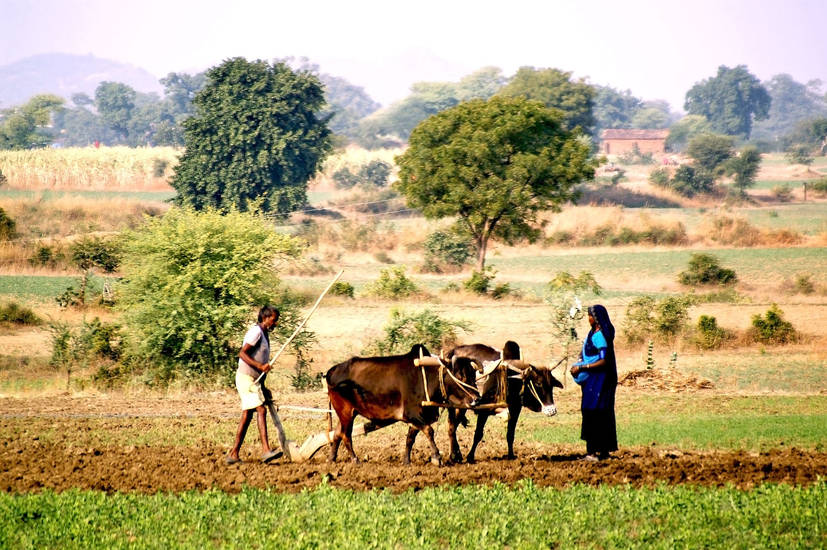






Roger Engstrom
February 23, 2024 (11:09 am)
Great information.
I think soils have been depleted since tillage began- even hand labor. We in Iowa are blessed with 25% of the world class A soil. The land was farmed starting in 1840s when Iowa became a state. Virgin prairie was broken for farming. Soil organic material was ten percent. Farming for the next one hundred years was livestock farming and crop rotation so very little tillage was done and even so only about every 4-6 years. Since 1950 livestock is less on land and more in confinement.
Tillage is every year and rotation is corn soy corn soybeans. On my farm which was conveniently tilled the SOM was less than three percent. 18 years ago I switched to strip till and Notill. No burning. No residue removal. Only grain is removed. All crop residue is left on the soil surface. That protects from temperature, erosion and rain drop damage. Residue is the food for soil organisms. They don’t like their food buried. They convert the residue into nutrients for the crop. My SOM is now near six percent. I have no runoff or erosion. Every drop of rain infiltrates where it falls.
Every percent of SOM holds 240,000 gallons of water per acre which is available for the crop. Water table and aquifer can be increased.
I just returned from north India. SOM is 0.1 in some places. It is time to learn how to increase the SOM. Also biochar will greatly speed up the process. Farmers now need appropriate equipment to help do this efficiently and economicaly.